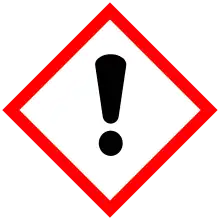| Names | |
|---|---|
| Preferred IUPAC name
Tridecan-1-ol | |
| Other names
1-Tridecanol Tridecyl alcohol | |
| Identifiers | |
3D model (JSmol) |
|
| ChEBI | |
| ChEMBL | |
| ChemSpider | |
| ECHA InfoCard | 100.003.635 |
PubChem CID |
|
| UNII | |
CompTox Dashboard (EPA) |
|
| |
| |
| Properties | |
| C13H28O | |
| Molar mass | 200.366 g·mol−1 |
| Appearance | White solid[1] |
| Density | 0.84 g/cm3[1] |
| Melting point | 32 °C (90 °F; 305 K)[1] |
| Boiling point | 274–280 °C (525–536 °F; 547–553 K)[1] |
| Practically insoluble in water[1] | |
| Hazards | |
| GHS labelling: | |
 | |
| H315, H319, H335 | |
| P261, P264, P271, P280, P302+P352, P304+P340+P312, P305+P351+P338, P332+P313, P337+P313, P362, P403+P233, P405, P501 | |
| NFPA 704 (fire diamond) | |
| Flash point | 120 °C |
| 260 °C | |
| Lethal dose or concentration (LD, LC): | |
LD50 (median dose) |
17200 mg/kg (rat, oral)[1] |
Except where otherwise noted, data are given for materials in their standard state (at 25 °C [77 °F], 100 kPa).
Infobox references | |
1-Tridecanol is an alcohol with the formula C13H28OH. It is a colorless fatty alcohol that turns white when solid. 1-Tridecanol usually occurs as a mixture of different isomeric to compounds such as 2-tridecanol, 3-tridecanol, 4-tridecanol, 5-tridecanol, 6-tridecanol, and isotridecanol.
Use
1-Tridecanol is used as a lubricant and for the manufacture of surfactants and plasticizers.
References
- 1 2 3 4 5 6 Record in the GESTIS Substance Database of the Institute for Occupational Safety and Health
External links
- Antibacterial Activity of Long-Chain Fatty Alcohols (PDF-Datei; 99 KB)
This article is issued from Wikipedia. The text is licensed under Creative Commons - Attribution - Sharealike. Additional terms may apply for the media files.
